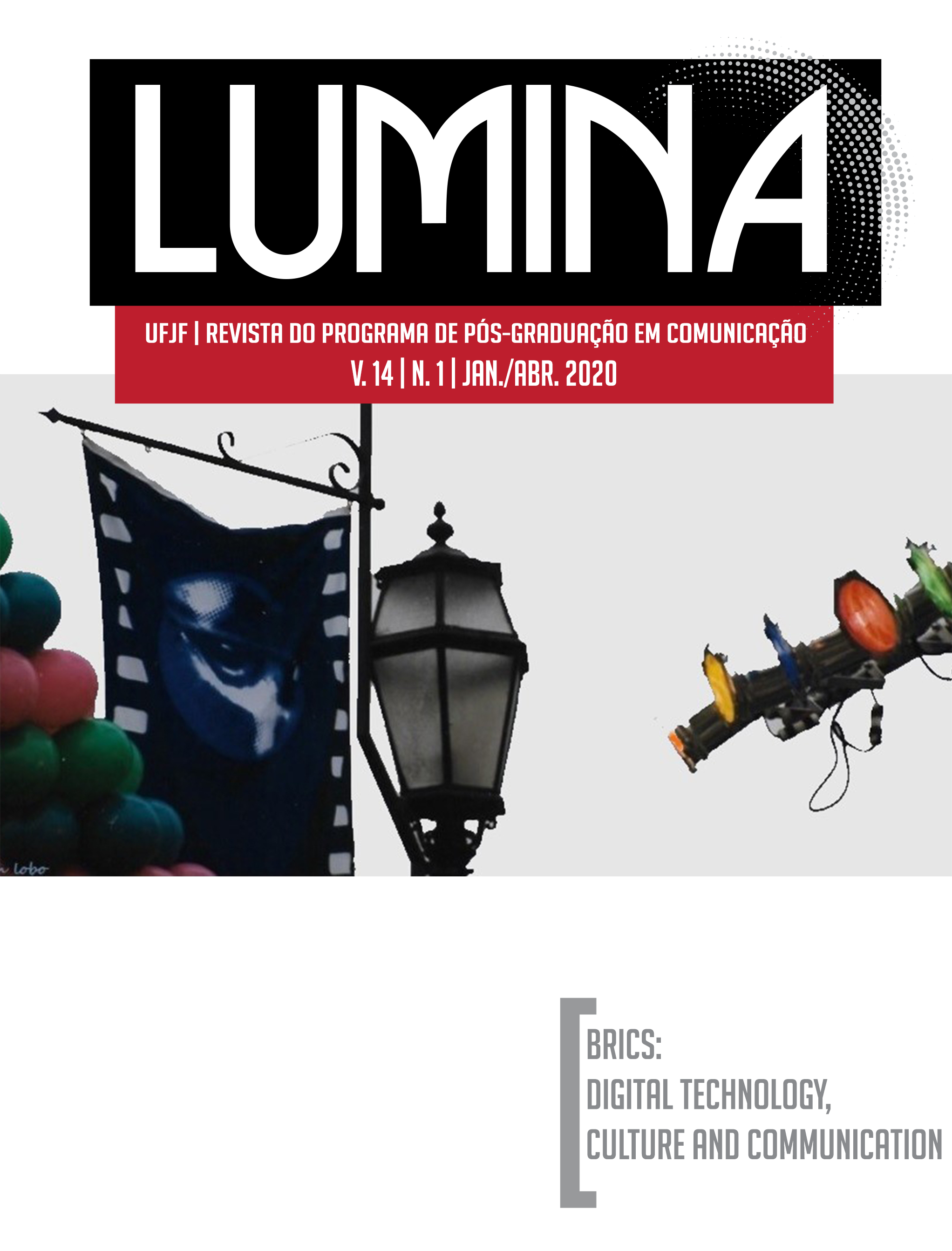Towards a full body narrative: a communicational approach to techno-interactions in virtual reality
DOI:
https://doi.org/10.34019/1981-4070.2020.v14.30019Keywords:
virtual reality, communicational process, multisensory interfaces, materialities of communication, digital narrativesAbstract
The essay approaches the sociocultural and technological issues linked to the communicational process that exists in the user’s relationship with immersive digital environments, specifically: Virtual Reality (VR). A critical look at VR as a communication interface is launched, precisely because it indicates assumptions of enhancing the creation of meanings on media surfaces by leveraging multisensory stimuli that cause the immersion of individual’s body in a 360° framed experience. To instigate the problematization about transformations resulting from these techno-experience, empirical explorations are conducted to Brazilian immersive environments. In addition, data are qualitatively analyzed based on Kerckhove, Gumbrecht and Flusser and others ideas to illuminate the debate of technical-images, digital narratives and appropriations on technological devices, media languages and coding in the digital age.
Downloads
References
BAUDRILLARD, Jean. Simulacra and simulation. Ann Arbor: Jornal da Universidade de Michigan, 1994.
BURDEA, Greg. Virtual Reality Technology. Nova York: Wiley & Sons, 2003.
DAVIDOFF, Linda. Introdução à psicologia. São Paulo: Makron Books, 2001.
DUBOIS, Phillipe. Cinema, video, Godard. São Paulo: Naify, 2004.
FLUSSER, Vilem. O Mundo Codificado. São Paulo: Ubu, 2017.
GUMBRECHT, Hans Ulrich. Production of Presence: What Meaning Cannot Convey. Stanford: Stanford University Press, 2004.
KERCKHOVE, Derrick. The Skin of Culture: Investigating the new electronic reality. Londres Kogan Page, 1995.
KILPP, Suzana. Interfaces Contemporâneas da TV: paradigmas durantes em telas de dispositivos móveis. Porto Alegre: Sulina, 2015.
KIRNER, Cláudio; TORI, Romero. Introdução à Realidade Virtual, Realidade Misturada e Hiper-realidade. In: KIRNER, C.; TORI, R. (orgs.). Realidade Virtual: conceitos, tecnologias e tendências. São Paulo: Editora Senac, 2004, p. 3-20.
MCLUHAN, Marshall. Understanding media: the extensions of man. Nova Iorque McGraw-Hill, 1964.
PAUSCH, Randy; Proffit, Dennis; Williams, George. Quantifying immersion in virtual reality, 1997. Disponível em: <http://www.cs.cmu.edu/~stage3/publications/97/conferences/siggraph/immersion/>. Acesso em: 18 dez. 2019.
SLATER, Mel; WILBUR, Sylvia. A Framework for Immersive Virtual Environments (Five): Speculations on the Role of Presence in Virtual Environments. Presence: Teleoperators and Virtual Environments. Cambridge: MIT Press, v. 6, n. 6, s/n, 1997.
SLATER, Mel; STEED, Anthony; USOH, Martin. Being there together. Technical Report, Department of Computer Science. Londres: University College of London, 2013.
SODRE, Muniz. A Ciência do Comum. Rio de Janeiro: Vozes, 2014.
THOM, Jan. Immersion Revisited. On the Value of a Contested Concept. In: FERNANDEZ, Amyris; LEINO, Olli; WIRMAN, Hanna (orgs.). Extending Experiences. Structure, Analysis and Design of Computer Game Player Experience. Rovaniemi: Jornal da Universidade da Lapônia, 2008, p. 29-43.
ZILLES BORBA, Eduardo. Entre Lugares e Imagens: o uso de dispositivo de realidade virtual e a percepção espacial. Revista E-Compós, v.21, n.1,p. 1-22, 2018. Disponível em: <https://www.e-compos.org.br/e-compos/article/view/1362>. Acesso em: 7 abr. 2020.
ZILLES BORBA, Eduardo; ZUFFO, Marcelo. Sinto, logo existo na realidade virtual. Tropos: comunicação, sociedade e cultura, v.6, n.2, p. 1-17, 2017. Disponível em: <https://periodicos.ufac.br/index.php/tropos/article/view/1532 >. Acesso em: 7 abr. 2020.
ZUFFO, Marcelo; SOARES, Luciano; CABRAL, Márcio. Sistemas avançados de realidade virtual. In: TORI, R.; KIRNER, C.; SISCOUTTO, R. (orgs.). Fundamentos e Tecnologias de Realidade Virtual e Aumentada. Belém: Editora SBC, 2006, p. 51-58.
Downloads
Published
How to Cite
Issue
Section
License
Autores que publicam nesta revista concordam com os seguintes termos:
- Autores mantém os direitos autorais e concedem à revista o direito de primeira publicação, com o trabalho simultaneamente licenciado sob a Licença Creative Commons Attribution que permite o compartilhamento do trabalho com reconhecimento da autoria e publicação inicial nesta revista.
- Autores têm autorização para assumir contratos adicionais separadamente, para distribuição não-exclusiva da versão do trabalho publicada nesta revista (ex.: publicar em repositório institucional ou como capítulo de livro), com reconhecimento de autoria e publicação inicial nesta revista.
- Autores têm permissão e são estimulados a publicar e distribuir seu trabalho online (ex.: em repositórios institucionais ou na sua página pessoal) a qualquer ponto antes ou durante o processo editorial, já que isso pode gerar alterações produtivas, bem como aumentar o impacto e a citação do trabalho publicado (Veja O Efeito do Acesso Livre).








